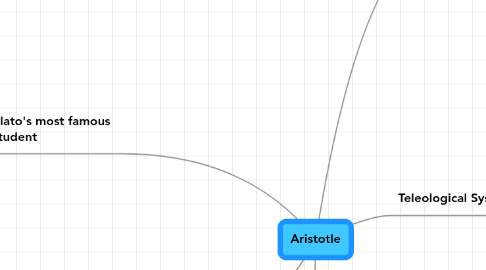
1. Plato's most famous student
1.1. Went back to focusing on the human and disagreed with Plato's concept of another world, which was real and perfect. He believed we were living in the 'real world' already.
1.2. Lived during the Late Classical Period (art history ; late classical art focused more on the human)
2. How does Aristotle differ from Socrates and Plato??
2.1. Aristotle is a scientific/practical thinker
2.1.1. Does not believe in the 'world of forms'. EVERYTHING WE CAN UNDERSTAND ARE THE TRUTH.
2.1.2. *He creates and applies a scientific model to philosophical investigation.
3. Connections
3.1. Doryphoros
3.1.1. MC: Bronze
3.1.2. FC: Perfection, reason, male, nude, young, warrior, thinking
3.1.3. EC: Chisela and hammer
3.1.4. Final Cause: * A didactic piece of sculpture. It teaches Greek virtues of reason, math is beauty, mathematical perfection, aesthetics.
4. Aristotle's Biology
4.1. " All men by nature desire to know."
4.1.1. He disagreed with Plato and Socrates and believed that we were given our senses to use them to understand the world. (Plato and Socrates said that senses would lead us astray,away from the the Truth, and trap us in the world of illusion.
4.1.1.1. To 'engage' the problem of knowledge we must begin with our senses
4.2. His theories
4.2.1. All living beings share 3 things: nutritive, reproductive, and locomotive power.
4.2.1.1. Plants
4.2.1.1.1. Plants have all these 3 but nothing else
4.2.1.2. Animals
4.2.1.2.1. Animals also have problem-solving abilities (intellectual power).
4.2.1.2.2. Humans have a special intellectual power : REASON. (the ability to make a choice based on the environment around them) *( ability to comprehend universals?)
5. Teleological System
5.1. Believed: Everything in this world has a cause( something that drives them to be created)!
5.1.1. Provided four classes of causes:
5.1.1.1. Material Cause:
5.1.1.1.1. *The Material from which the thing is made.
5.1.1.2. Formal Cause:
5.1.1.2.1. *The shape or form a thing must take in order to be recognized.
5.1.1.3. Efficient Cause
5.1.1.3.1. *The actual force used to make the thing
5.1.1.4. FINAL CAUSE
5.1.1.4.1. * The ultimate purpose of the thing
5.1.2. Where do the forms reside?
5.1.2.1. Thought that the forms lie inside the things themselves. 1.Example; the form of the oak lies in the acorn..
5.1.2.2. *Each thing that we see is part of a teleological(goal-oriented) system.
5.1.2.2.1. What humans want : To be a morally excellent/fully ethical person who is virtuous [aka - arete]
